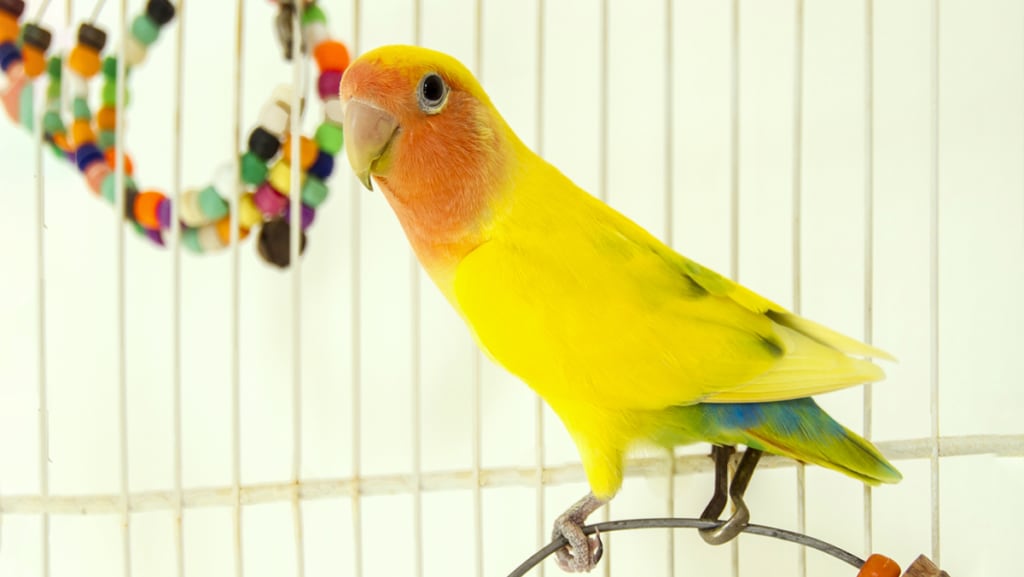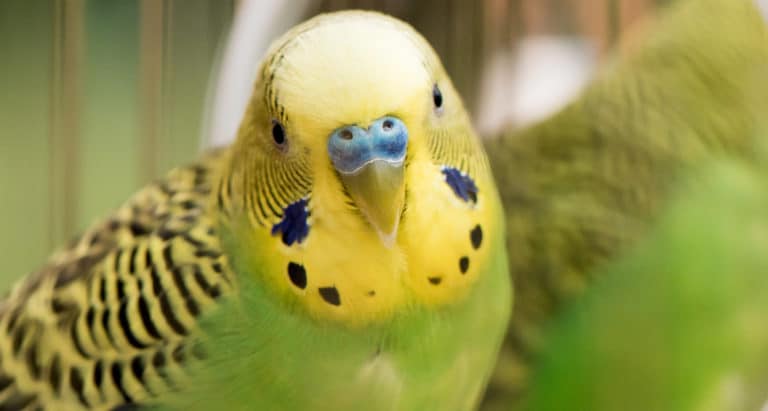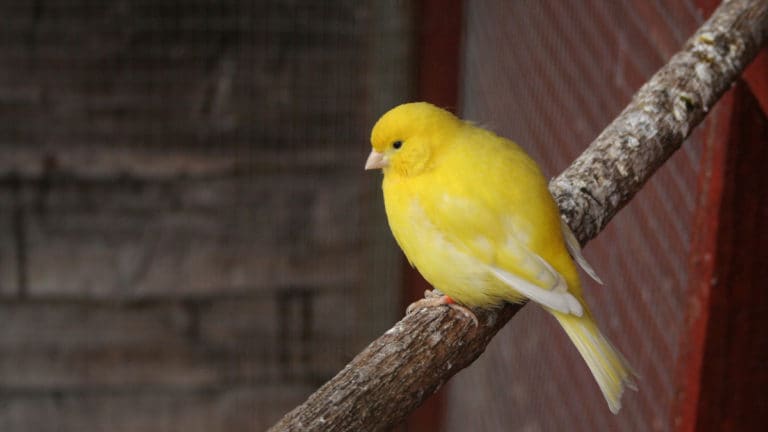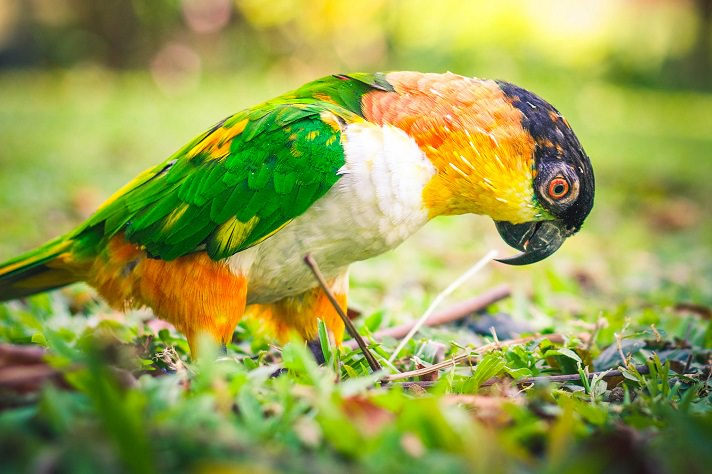Many pet birds approach toys with extreme caution (read here: “toys freak me out”), but not lovebirds. With lovebirds, toy acceptance is not an issue. The question isn’t “Will my lovebird like the toy?” but rather, “Is the bird toy safe?” or even, “Will my lovebird like the bird toy too much?”
It’s hard to imagine a more anthropomorphic behavior issue than becoming too attached to toys, but like people, lovebirds love their toys—sometimes too much.
“Lovebirds like toys they can snuggle with, but if you have a female bird, these toys could stimulate egg production,” says Byron J.S. de la Navarre, DVM at the Animal House of Chicago. “This can be taxing on their health.”
Egg production can deplete your bird of calcium and protein, which can lead to serious health issues, so you may want to avoid nest boxes and similar toys, he says.
But there are plenty of other toys your bird will love that won’t cause this side effect and lovebirds really need their toys.
Play to Their Intelligence and Size
Because of their curiosity and activity level, lovebirds require stimulation, de la Navarre says. Without the interaction and enrichment toys can provide, they can act out and turn to self-destructive behaviors like over-preening and chewing. And without proper bird toys, lovebirds will turn to their own devices and make ordinary objects into toys. Unfortunately, this puts them at risk for plenty of accidents in the home, including suffocation/smashing dangers (bed covers, furniture), hiding in places where they might not be found for a while (infrequently-used drawers, couch cushions) or entanglement (afghans, drapes, rope toys).
As a general guideline, de la Navarre recommends choosing toys that are categorized for lovebirds and use simple methods to keep them entertained.
Rotate your bird’s toys, put them away for a few weeks and then re-introduce them, he says. Not only will this add to the longevity of the toy, it will be like reuniting your bird with a long-lost friend. To help find toys that appeal to your lovebird’s instincts and traits, here are some other expert tips.
Places to Hide
Fascinated by tiny spaces that they can crawl into, lovebirds make their way into sleeves, drawers, and other tight spots. Protect your birds from accidents by giving them approved areas and toys to hide and snuggle into when they want like the Super Bird Creations Peekaboo Perch Bird Tent. They also like to hide or play peeking out games from behind a toy. For this purpose, the larger the toy, the better.
There is no cavity too small for a lovebird to try to explore, no enemy too large to be challenged by this little feathered dragon. These qualities account for a major part of the mystery and enchantment of the lovebird.
Happy Feet
A solitary lovebird with nothing to do might lose interest in almost everything except eating and preening, occasionally even overpreening and destroying feathers. Fortunately, this is extremely rare because of its penchant for finding ways to play.
Gail Hail of Aussie Bird Toys suggests appropriately-sized foot toys as a lovebird’s first toy — even before the bird learns to perch. This introduces safe play with its feet and beak and contributes to the development of coordination. Whether it’s a bit of plastic rope with a bead knotted on it or a tiny wooden dumbbell, a simple foot toy, like the JW Pet Activitoy Birdie Guitar Toy, can provide hours of entertainment. Offer your lovebird a daily basket of foot toys.
As your lovebird matures its toy preferences might vary from year to year or even day to day, but always provide it with a good variety to sample.
Chew Toys
Destructible bird toys appeal to a parrot’s instinct to chew, but use them with caution for lovebirds. The chewing instinct of most lovebirds is probably geared toward the production and collection of nesting material.
Instead, opt for chew toys that don’t come apart in strips like Planet Pleasures Pineapple Foraging Bird Toy. These include leather, sisal and plastic ropes of appropriate length and design; soft woods that splinter; bird-safe materials that break apart in chunks — any items that don’t resemble nesting material. Paper and plastic straws are appropriate unless the bird begins collecting them and using them for nest construction.
Ring in the Fun
Sound-related toys create or enhance sounds, which appeal to the lovebird’s instinct to communicate. Bells are the most common and easily accessible sound-related toys. Bird-safe liberty bells are now especially designed for safety with one-piece clappers that drop to the floor when removed by the lovebird. You might also try plastic pipe bells, rattles and clackers with hard plastic beads, because they make sound but create less noise. Lovebirds use toys with cavities of any kind for resonating — for chirping into and listening. Try the JW Pet Activitoy Birdie Disco Ball Toy.
Throw in Some Action
Interactive toys appeal to the lovebird’s intellectual and emotional needs. Usually constructed of indestructible or difficult-to-destroy materials, these toys challenge your smart, busy bird. Food or destructible elements incorporated into the design get the bird’s initial attention.
Foraging toys, whether foraging is the primary function of the toy or a small part of its function, offer long-term play opportunities. Lovebird owners sometimes just clip a spray of millet someplace unexpected to encourage their bird’s foraging instinct. Try Kaytee Natural Spray Millet Bird Treats.
Lovebirds also like to fight their toys. This surrogate enemy or rival is often metal and probably hangs near the side of bird cages where it can be loudly banged against bars. A lovebird might have many surrogate enemy toys. If a toy isn’t a surrogate enemy, it could be a surrogate mate. It might be both.
Many pet birds are attracted to mirrors, but provide these to your lovebird with careful observation. Actual glass mirrors have the potential for both behavioral and physical damage because of their very accurate images, their backing and breakability. Some birds become obsessed with their reflections, sitting in front of them for hours while they talk and show off for their friend. Shiny acrylic, stainless-steel or nickel-plated mirrors are more durable and behaviorally desirable for their indistinct, inaccurate reflections in which the bird can see movement but not another bird. Try JW Pet Activitoy Birdie Bowling Toy which features a shiny mirror to keep your bird engaged while he tries to “knock over” the bowling pins.
Fun and Fitness
Exercise toys are especially important for lovebirds with trimmed wing feathers to maintain good health and disposition.
Many lovebirds love swings and do so vigorously, almost violently. Some swing front to back in the manner of traditional human swings, but many enjoy swinging side to side or in circles. For this type of activity, try the JW Pet Activitoy Birdie Olympia Rings Toy.
Many lovebirds like to hold onto their perches and flap their wings. To facilitate this healthy behavior, outfit your bird’s cage with grippable perches, something small enough to be gripped all the way around rather than simply stood upon.
Although some people don’t allow parrots access to the cage top, I believe that birds with trimmed wing feathers require at least a little time atop the cage to hold bars and flap vigorously.
Large spirals of stiff cotton rope perch like the Super Bird Creations Rainbow Bridge Toy, can provide many happy hours of swinging, bouncing and climbing. A bridge or boing placed over a toy also provides more opportunities to present toys in interesting ways as well as exercise.
Good Clean Fun
Lovebirds love to bathe and will do so in any manner they see fit — in the sink, the water dish or any bowl of water. Because these bold feathered explorers love water they’ll also hop into a toilet, a half-full glass, a mop bucket or an undrained bathtub — all of which pose drowning hazards. Keep an eye on your bird when its out of the cage. Or create a bathing area for your bird with the JW Pet InSight Inside the Cage Bird Bath.
The world of indoor lovebirds might seem limited in scale, but, thanks to the magic of toys, we can create an almost unlimited potential of exciting things to do.
Chris Brownlow has been writing about pets for over 10 years. As a writer who believes in immersing herself in her topic, she has tasted more than 20 different flavors of dog and cat food while working on an advertising campaign for PetSmart. Prior to her pet days, Chris was a print and digital journalist at The Tampa Tribune and The Virginian-Pilot.
Share:



















